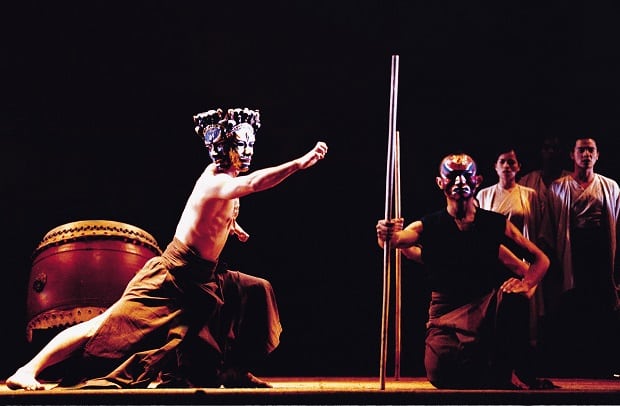A powerful performance that evokes a sensuous and spiritual feeling in the audience

The seventh OzAsia festival opened, literally, with a bang to the beat of seven drums and two large gongs in the opening act of Meeting with Bodhisattva. The huge drums took me back to the opening ceremony of the Beijing Olympics and even further to the famous Tamil movie Chandralekha (1948), where a bevy of beautiful girls dance on top of some fifty massive drums, a scene bigger than Ben Hur. The venue was Her Majesty’s Theatre, a neo-classical building that has just celebrated its centenary, and was appropriate to hold this event.
Although the play is based on a classical theme, it is presented in a modern ballet format. In essence it expresses a ‘journey of a man facing his fears as he enters unknown territories; a journey from questioning everything to accepting anything that happens to him for better or worse’. There is no dialogue. It is left to the audience to understand the Buddhist mantra, ‘get rid of impurity and relinquish the dualism that divides thought and action’. This dualism is well brought out by an interesting mix of contrasts, non-stop movements by characters and moments of absolute stillness; billowing sound of drums and stony silence; waving long sticks in threatening gestures and gentle tai chi-like movement of limbs; soul-stirring music but no lyrics; constant flow of messages through body language, and yet hardly any words.
This unique presentation by Taiwan’s U Theatre features sixteen dancers who slice through the air, striking their instruments – drums, gongs and cymbals, with immaculate precision. The sixteen players – seven women and nine men – are all attired in uniformly looking long off-white robes; it is hard to tell them apart from a distance, except for the bun-like hair-do of the women. They seem super-fit and yet supple as the 90-minute show demands constant movement of the players, especially the central character.
He is there from start to finish prancing, jumping, twirling, while at the same time waving his stick in mid-air, tapping the floor and hitting the drums. At times he uses his staff to fend off others seemingly attacking him with long sticks. This is very much like the ‘silambattam’ in Tamil Nadu, where similar fight scenes were once seen in rural areas. It is also akin to certain Japanese stick play I saw a few years ago. When Buddhist monks from India were sent out to foreign lands to spread their message, they were instructed not to harm any attackers but defend themselves with their sticks and other forms of martial arts which later took deep roots in those countries, giving the impression that they originated from there.
The stamina of all players is phenomenal in this immensely physical tale of the search for inner calm among chaos. In the last but one scene, all of them whirl round and round – like the Dervishes of Turkey- for almost an eternity, to the accompaniment of soulful music in slowly dimming light.
The seven acts move seamlessly with no curtain drop. The huge drums and gongs are moved in and out on special skates, without a squeak. In the entire play only three words are uttered. The background music, audible when the drums are not struck, is soft, soulful and sensuous. A few times when the gong is struck, the sound of ‘Om’ emanates and lingers for long, giving the performance a spiritual feel.
Bodhissattva is a beautiful blend of athletic drumming, Buddhist chanting, martial arts and meditation where the players’ bodies act out a language both religious and artistic, as the drums and gongs fill the hearts of the audience with a sensual and spiritual feeling. It is a unique narrative of one man’s chance meeting with a deity whose only way to wisdom is through letting go.
A melange of martial arts and meditation

Reading Time: 3 minutes



